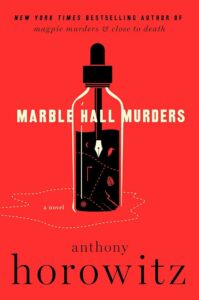Susan Ryeland #3
 If traditional, golden age style mystery is your jam, these books are absolute perfection. Though it’s a series, and the main character, Susan Ryland, has her life change drastically between the volumes, you could definitely read each one as a standalone and not be lost. Of course, if you like golden age style traditional mysteries, you’re going to read them in the order the author intended regardless, right?
If traditional, golden age style mystery is your jam, these books are absolute perfection. Though it’s a series, and the main character, Susan Ryland, has her life change drastically between the volumes, you could definitely read each one as a standalone and not be lost. Of course, if you like golden age style traditional mysteries, you’re going to read them in the order the author intended regardless, right?
As Anthony Horowitz has proven himself to me to be some kind of genius, I always find that it’s a good idea when opening one of his books to just relax and trust that he will reliably serve up a great story. In this instalment former editor Ryeland has returned from her idyll in Crete after abandoning both the hotel business and her boyfriend. She decides to take on freelance editing work (the reason why it’s freelance is explained in the earlier books), and the first assignment that comes her way is the continuation of the Atticus Pund series. Pund, a detective working in the 1950s, was the creation of her former client, the late Alan Conway, who grew to hate his detective and decided to give him a fatal illness. The title of the new book, then, is Pund’s Last Case.
The author in charge of the re-boot is the spoiled, troubled heir to the fortune of a wildly successful (now dead) children’s author. Susan expects him to be trouble, and he certainly is, but despite herself and her reservations about the entire project, she finds herself intrigued by the book itself. As in Horowitz’s other works, there’s a book within the book. In the first instalment (Magpie Murders) the ending was missing as the author died before he could finish, and in this one, Elliot, the new writer, has given her only about a third of the book, but the portion she gets is certainly captivating.
Set in France in 1955, it follows the family of a wealthy woman who dies suddenly, though not completely unexpectedly. She’d reached out to Atticus before she’d left for the South of France, and although he hurries over, he arrives too late. He now feels obligated to investigate, much to the annoyance of the French policeman in charge who views him as an intrusion. Much like his avatar Hercule Poirot, however, Pund is so brilliant that his insights are eventually not only tolerated but eagerly sought after.
Meanwhile Susan is waiting for the next bit of the novel only to discover that her client is ignoring her advice, drinking, and mistreating his girlfriend. He fires her shortly after a disastrous radio interview she’d advised against, but she still attends the family party she’d previously been invited to. There she discovers that the family in the book and Elliott’s actual family are obviously not only connected but nearly mirror images. Susan spends the time after her dismissal looking into Elliott’s past, visiting his family home (now open to the public), and talking to the folks from his past that she is able to track down. When a death occurs and Susan becomes the prime suspect, she must continue to investigate in order to prove her innocence, and she forms a fragile alliance with the detective in charge of the case.
As with every Horowitz novel, the reader is treated to a lovely dance, with plots and characters intertwining, and you can reach the halfway or three quarter point still not feeling completely sure of what may or may not happen next. While the ending was not as tricky as some of his other books, it’s still an adroit sleight of hand that is beautifully set up and knocked down. With this strong instalment, Horowitz proves once again that these smart, gorgeously written and compelling books remain some of the very best crime novels being written. — Robin Agnew